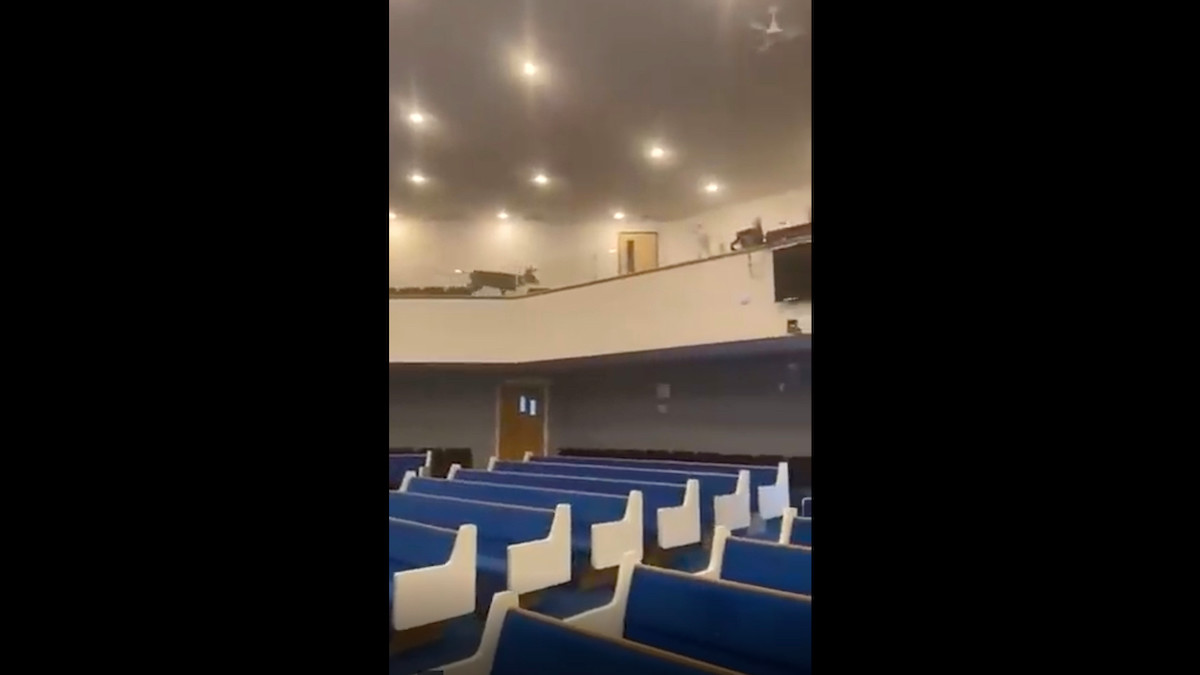
Most whitetail hunters spend more time looking for deer than looking at deer. The most popular North American big game animal is infamously skittish around humans, and it’s safe to say that, with the exception of this city in Japan, cervids around the world avoid highly populated areas like their lives depended on it.
But if that’s the case, how do we explain this 10-point whitetail buck that broke into a church in Sturgis, Michigan, on the opening day of rifle season?
Or this four-year-old doe that wound up at the top of an escalator in Baton Rouge’s largest hospital?
Or this Wisconsin doe that sparked a minor social media controversy after TikTok footage emerged of a Walmart employee holding it down inside the store?
These incidents don’t describe typical behavior, but deer end up in buildings more often than you might think. All these stories were published in the last three months. Chad Stewart from the Michigan Department of Natural Resources told us his agency sees this kind of thing all the time.
“We have encountered deer in churches, houses, grocery stores, department stores, and on top of ski jumps, to name a few,” he told MeatEater’s Ryan Callaghan on the Cal’s Week in Review Podcast. “With deer being relatively abundant throughout much of Michigan, you occasionally get individuals who find themselves in less-than-ideal situations, for both them and humans.”
The wildlife biologists we interviewed all mentioned a few reasons a deer might enter a building, but the rut was the most frequently cited. Hunters rely on the rut to lower deer inhibitions, but that lack of caution can land a whitetail in hot water in other ways too.
Jim Heffelfinger of the Arizona Game and Fish Department told us that a buck will sometimes see his reflection in a window and think he’s seeing a competitor. During the rut, another male in such close proximity is all the motivation he needs to charge through a window.
That’s what Stewart believes happened to the church-going Michigan buck mentioned above.
“It’s purely speculative from my standpoint but it is almost definitely associated with behavior during the breeding season,” he said. “Because the breeding season is happening in Michigan, the deer either had sins to confess or more likely saw its reflection in an outdoor window and attempted to fight itself and crashed through.”
Brett Skelly of the West Virginia DNR has heard about deer in his state finding their way into department stores, sheds, and even a technical building at West Virginia University.
“They thought it was a break-in,” Skelly said of the university incident. “There was broken glass everywhere after it jumped through one of the windows.” The doe ran out of the classroom and into a bathroom, where wildlife officials tranquilized it with a dart gun. They let the deer free outside a nearby fence.
Skelly also named the rut as the most common reason a buck might wind up in a building, but he’s not sure what motivated that doe to jump through a window. Both Stewart and Skelly said deer also end up in buildings when they’ve been spooked or injured.
“They could be trying to run away from something, and they might see a reflection that they think they can get through,” Skelly said.
Windows designed to be reflective to prevent bird collisions could have the opposite effect on deer. For example, if a window reflects a stand of trees, a deer might think it can run in that direction to escape.
Deer that have been injured by cars can become disoriented and wander into places they wouldn’t otherwise go. The Baton Rouge incident mentioned above involved a deer that had been recently struck by a car, and Stewart thinks that’s the most likely explanation for its behavior.
“That’s a perfect example. An animal experiences a stressful or traumatic event and in getting out of that situation gets itself into a new situation,” Skelly said.
He also mentioned an incident involving a deer that wandered into a shed after being hit by a car. “It was rubbing its head on the wall, bumping into things,” Skelly said. “When they cut the head open, they saw it had a massive concussion.”
Food or shelter aren’t likely explanations for deer in buildings, these biologists say.
“You don’t want to anthropomorphize the animal,” Stewart said. “It’s not going inside because it’s hungry or cold. That’s a far more stressful situation for the deer than its natural setting.”
If you ever encounter a deer in a building, Stewart and Skelly both recommend keeping your distance and encouraging it to exit the way it came in. Stewart also pointed out that since deer often travel along edges (forest lines, fences, etc.), you might coax it along a wall to the nearest door or window.
“The first priority is human safety, but in most instances, you should be able to get the deer out by guiding the animal the way it came in,” Stewart said. “If you try to rush them too fast, their actions become unpredictable. Give them space but try to guide them down that path.”
If the deer has wandered so far into a building that it won’t be able to locate an exit, Skelly recommended keeping it in a room and staying away until a game warden or biologist can deal with it. They’ll have the tools and training required to tranquilize it and get it to safety.
“Getting kicked by a deer puts you on your backside in a hurry,” he said. “If you can wait, try to isolate the animal and keep it as relaxed as possible until someone can get there.”
Ultimately, a deer in a building is a sometimes funny, sometimes sad reminder that human infrastructure often encroaches on wild spaces and animals.
“They do weird things,” Skelly said. “We are in their habitat. We encroach on them, not the other way around.”






